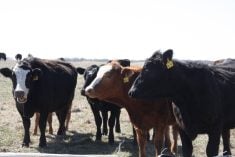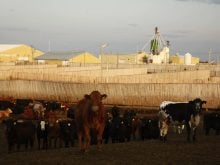U.S. fed cattle hit record
A few cash fed cattle sales in the United States fetched a new record high of US$171-$172 per hundredweight.
Alberta direct cattle sales were too few to allow a market trend to establish. The Alberta cash market has now shifted to a bi-monthly flush of sales with packer bids generally based off contracts.
However, a handful of dressed sales were reported with prices at $290-$292 per cwt. delivered, generally steady with the previous week.
U.S. buyers showed interest, but sales did not develop.
Read Also

Flax sector sees omega-3 opportunity
SASKATOON — A global shortage of omega-3 oils could be an opportunity for the flax sector, says an industry official….
The fed basis is weak for this time of year at around -$19.50.
Weekly western Canadian slaughter to Nov. 8 fell 14 percent to 30,307 head.
Weekly exports to Nov. 1 fell six percent from the previous week’s strong level to 10,976 head. Exports for the two weeks were about double the pace of last year at the same time.
Cattle futures established new record highs but may soon face the risk of a profit taking liquidation.
Cow prices up
The volume at auction increased, but prices edged higher.
D1, D2 cows ranged $116-$135 to average $126.50. D3 cows ranged $104 -$120 to average $110.67
Western Canadian cow slaughter totalled 7,670 head, up 15 percent from the previous week but 22 percent smaller than the same week last year. Feeder cows averaged slightly more than $135 per cwt.
Export volumes to the U.S. have been brisk, but there is speculation that domestic supply could begin to build if Canadian slaughter does not increase.
Feeders stabilize
Light stockers found stability following four consecutive weeks of lower prices, while feeders heavier than 800 pounds traded mixed.
Replacement or breeding quality heifers are fetching premiums similar to last year at five to 10 cents a lb.
Prices in the yearling trade are being dictated more by quality than quantity.
In Manitoba, 450 to 650 lb. heifers are trading at a premium over Alberta and Saskatchewan, while steers in the same weight range are trading at steady prices across the West.
Given the freight costs, few Manitoba calves are likely to go to Alberta feedlots.
Weekly feeder exports to Nov. 1 totalled 15,181 head, which was more than double the pace last year.
More pregnancy checked open replacement quality heifers will soon be on the market, and the steer-heifer price spread might narrow on feeders heavier than 900 lb.
Beef edges higher
The Choice cutout was US$251.35, up 83 cents, and Select was $238.93, up $1.68. The Montreal wholesale price for delivery this week rose to C $308-$310 per cwt.
Prairie cattle on feed
There were 861,518 cattle on feed in Alberta and Saskatchewan feedlots, down three percent from last year.
Placements in October were 318,138, up six percent, thanks to a heavy run of calves and a significant number of forward sold calves being delivered.
The placements tended to be lighter calves. Heavier placements weighing 700 lb. or more fell 12 percent.
Marketings in October were 148,284, up 13 percent over last year.
Market-ready supply will start to tighten. Total placements over the past four months were 43,500 head fewer than last year, and many of the cattle will not be at market weight for several months.














